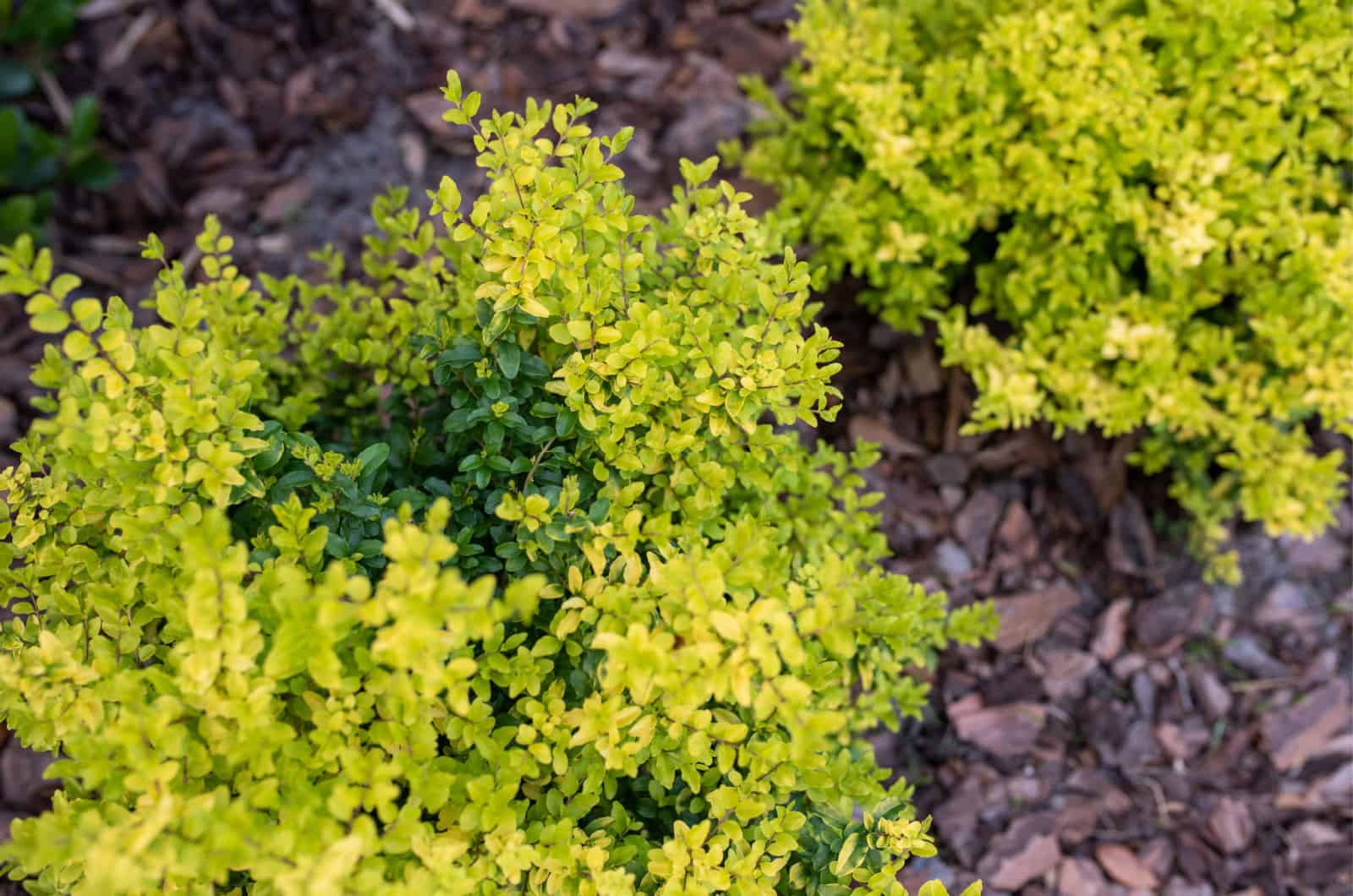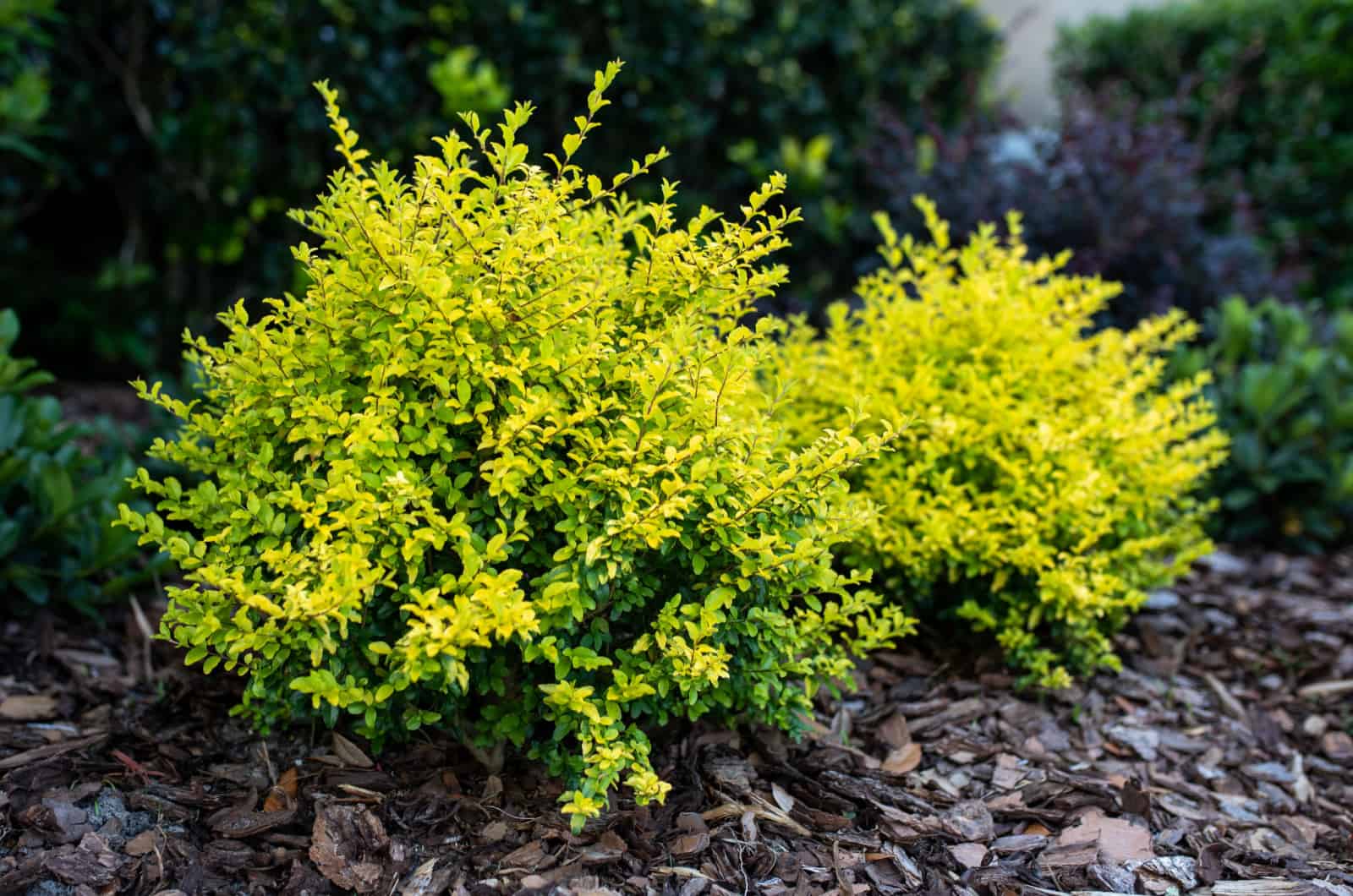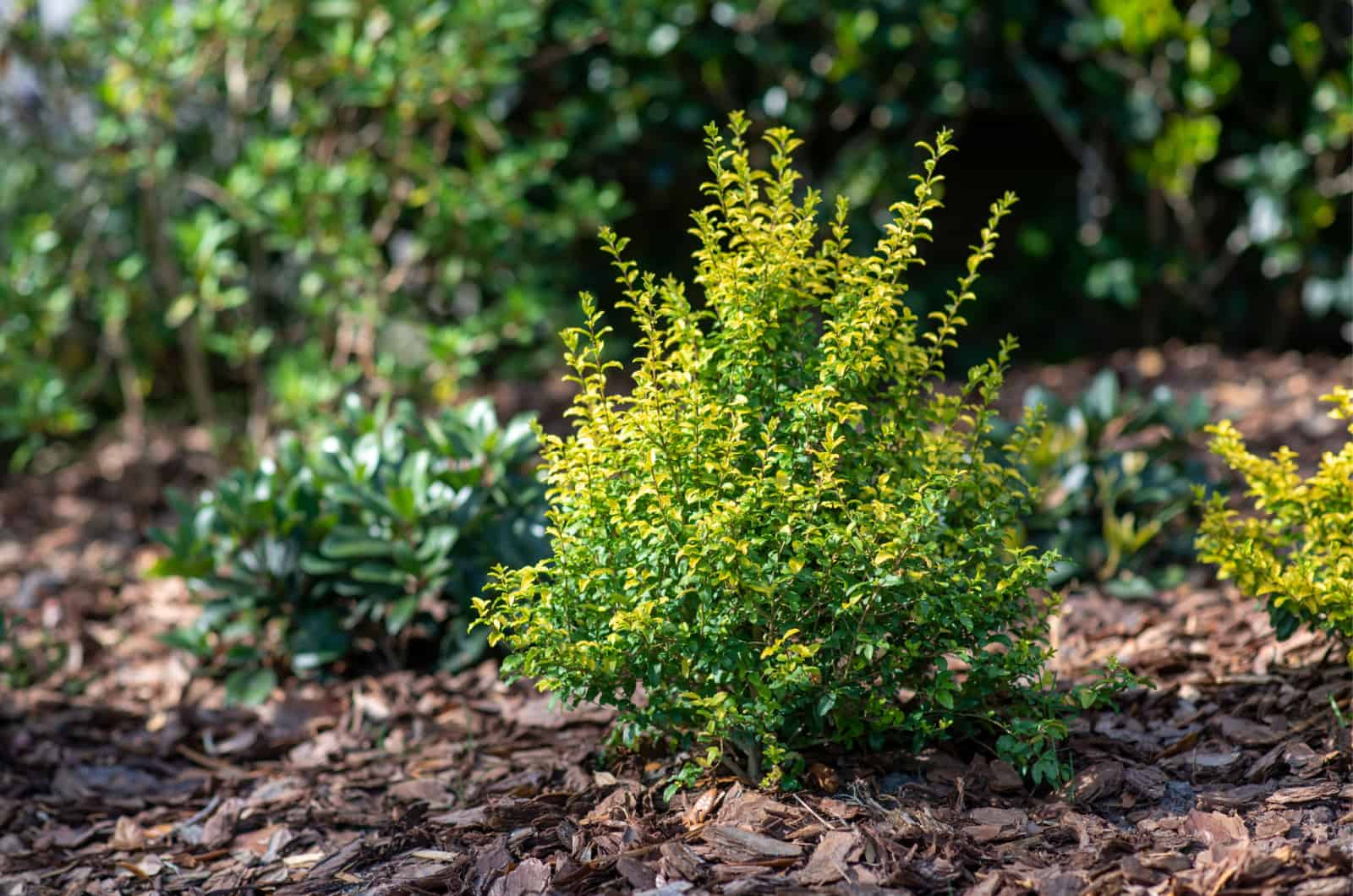Sunshine ligustrum is an evergreen shrub that adorns front yards and rims patios all over the world.
If you want to add this wonderful plant to your garden, you’ll definitely need to learn how to care for a sunshine ligustrum in winter.
Luckily for you, this article contains everything you need to know about the sunshine ligustrum, including whether it’s truly a cold-hardy plant, what amendments you need to make in order to keep it alive until spring, as well as some interesting facts about what can happen to this shrub in winter.
Before we get into all that, let’s look into some general specifics about the sunshine ligustrum:
[table id=276 /]
How To Care For A Sunshine Ligustrum In Winter
Striking Golden foliage is what makes this privet so desirable among gardeners. Another great thing is that it isn’t deciduous either, so you can enjoy its bright yellow leaves (that go perfectly with any of the pittosporum hedge varieties) all year long!
However, sunshine ligustrum care in the summer and winter months is not the same because this perennial requires more protection during cold weather.
The degree of protection they require also depends on your climate and growing zone – if you live in a warmer region, you don’t need to shelter this shrub that much.
We’ll now take an in-depth look at four tips on caring for this plant in winter!
Water The Shrub
Sunshine ligustrum is a drought-tolerant plant, but that doesn’t mean you should just leave it to nature’s mercy – especially in winter!
This shrub doesn’t require too much water, but you should still irrigate it every other week. Dehydrated plants have little chance of surviving through the winter, and there’s another benefit to it.
Plants that don’t receive enough water will seek it on their own by spreading their roots, and if they stumble upon your plumbing, they might penetrate your pipes.
Therefore, watering your shrubs in winter can save you a lot of trouble (and money)!
It’s also a good idea to mulch this shrub after planting to help the soil retain more moisture and keep your plant’s roots warm.
How To Water Shrubs In Winter
Even though watering plants isn’t rocket science, there are still some techniques that can make it more successful and prevent water from freezing in cold weather.
For instance, you should irrigate your ligustrum plants when the air temperature is 40°F or above so the plant can absorb the water before it freezes.
Make sure the soil isn’t frozen and water the plants at midday when the temperatures are at their highest. This technique allows your plants to hydrate before cooler temperatures arrive.
Water your plants slowly and at shorter intervals to prevent pooling. When the roots of these shrubs are exposed to too much water, they can get infected with root rot, which will kill them if left untreated.
Ensure It Gets Enough Light
Sunshine ligustrum is excellent for mass planting, but caring for it in winter requires a bit more attention than just watering it every couple of weeks.
It flourishes in full sun conditions and displays the most vivid shades when it gets plenty of light.
However, the sun isn’t just important for the sake of color – it also keeps your plants warm during the cold seasons and prevents them from dying.
Therefore, you should choose a location that gets plenty of sunlight during the day, so your ligustrum doesn’t freeze to death.
However, if you live in a warmer region with hot summers, you can plant this shrub in a spot that gets some shade in the afternoon hours, so the harsh light doesn’t burn its leaves.
Avoid Pruning
Pruning plants entices new growth, which is quite delicate and has little to no chance of surviving the winter cold.
The plant would direct its energy and food resources towards the new leaves and twigs, which would make it less tolerant of the harsh winter conditions.
You should stop trimming this plant approximately two months prior to the first frost date so it can save food and energy to use when the winter arrives.
Cover It Overnight
Ligustrum is a cold-hardy plant that can survive freezing temperatures. However, if you live in a region where temperatures below 0°F are an everyday thing, you should consider covering new plants overnight.
Established plants can deal with the cold much better, but they could also benefit from a bit of warmth during cold nights.
You should cover this ligustrum with a freeze cloth, tarp, or regular blanket when there’s no sun and the temperatures are freezing.
Take off the cloth in the morning and then cover it again if the temperatures don’t increase.
What Happens To Sunshine Ligustrum In Winter?
Sunshine ligustrum is a beautiful shrub that doesn’t mind the cold. However, if the temperatures are quite extreme, it may suffer a bit, and you’ll notice the color of the foliage changing and leaves dropping.
You should provide more protection during these periods.
Thankfully, this plant reacts positively to pruning and will reach its mature height in no time, regardless of the loss of a few leaves.
Leaf Drop
Sunshine ligustrum leaves dropping is quite normal in cold weather, but there are a couple of things you can do to minimize loss.
You can cover the shrub with a freeze cloth or some other material that will keep it warm during cold nights or move it to a more sheltered spot such as a garage or basement.
Avoid sudden temperature swings because that can lead to more leaves falling off. Don’t move your plant to a warm place, a cold garage or basement are perfect because your plant is sheltered from the harsh winter winds.
Remember, sunshine ligustrum can tolerate temperatures well below freezing, so you don’t need to move it to a warm location.
Also, leaf drop is not caused exclusively by freezing temperatures. Pests such as scales, aphids, and spider mites can all lead to foliage falling off. Scales will feed on your plant’s sap and really damage it if not caught early, so make sure to check on your plant from time to time.
Underwatering and either too little or too much sunlight can also cause leaf drop, so remember to water your plant (even in winter) and plant it in a well-lit location.
Foliage Color Change
Leaves changing color in winter is quite normal, so don’t be alarmed if you wake up one day to find that your ligustrum has turned a little orange.
The plant will spring back up as soon as the warmer weather arrives, and you can always prune the leaves when spring approaches.
Of course, the brightness of the color depends on the amount of sunlight your shrub receives. Plants don’t get as much light in winter as they do in the summertime, so choose the location carefully before planting a sunshine ligustrum.
Companion Plants For A Sunshine Ligustrum
This ligustrum shrub is available at the Southern Living Plant Collection or your local garden center, but don’t reserve your entire garden just for this plant.
Sunshine ligustrum loves company and goes well with colorful flowers and darker hedges. You can plant it with a leaf ligustrum to add more dimension to your landscape.
Also, the simple care guide of the Cherokee Princess dogwood makes this white-flowering tree an excellent companion to the sunshine ligustrum.
Loropetalum varieties such as Purple Diamond and Purple Pixie are excellent choices and accompany this plant perfectly. The orange rocket barberry will make the bright yellow color stand out even more.
How To Plant The Sunshine Ligustrum
Planting a ligustrum is pretty straightforward: dig a hole and place the plant in it!
Of course, it requires a little more finesse than that, but that’s essentially everything.
The first thing you should do is water the plant thoroughly before planting and choose a sunny spot in your garden for your sunshine ligustrum.
Then dig a hole twice as large as the pot and plant the ligustrum in it. Free the roots before backfilling the hole, and you’re done!
Water the plant again and wait for the soil to settle. You can also add some more substrate if there’s any need.
The sunshine ligustrum loves well-draining growing mediums, so add some loam-based compost or other ingredients that improve drainage and aeration.
You can start feeding sunshine ligustrum with a slow-release 15-5-10 fertilizer in early spring, but stop the fertilization a few weeks before the first frost date, so the cold doesn’t damage new growth.
Frequently Asked Questions
Sunshine ligustrum is an interesting plant, so it’s not surprising that there are so many questions about it online.
We picked a few that you asked us the most frequently and will answer them in the sections below.
What are the benefits of sunshine ligustrum?
One of the main benefits of the sunshine ligustrum is that it is ideal for allergy sufferers because it doesn’t produce flowers.
They are also an eco-friendly way of fencing your property and adding a splash of color to your garden.
They are easily shaped, so you can create eye-catching figures everyone will be jealous of!
They don’t mind being planted in-ground or grown in containers, which means you can get creative and choose vibrant pots for these shrubs.
Lastly, it is not an invasive plant like some other ligustrum varieties, so you can plant it without worrying about what it might do to your other plants.
Does the sunshine ligustrum have berries?
No, the sunshine ligustrum doesn’t have berries or blooms. The birds might not have anything to snack on, but the lack of berries is not entirely a bad thing.
Ligustrum fruit contains seeds that spread easily, and as the plants aren’t too demanding, they stretch their roots very quickly.
It is precisely this feature that makes them somewhat invasive, but because sunshine ligustrum doesn’t contain berries, it doesn’t spread and invade the personal space of your other plants.
What are the best pruning methods for ligustrum?
If you want to make some room for new leaves, you should prune the ligustrum in early spring. However, heavy pruning for size reduction and shaping is best done in the late winter while the plant is still dormant.
Use sterilized and sharp pruning shears when cutting this plant to avoid transferring bacteria or fungi to your healthy plant. Also, dull tools will tear the branches rather than cut them, which may damage the plant.
This plant grows fast, so it’s best to use ergonomic tools that don’t demand too much pressure and strength to cut, such as secateurs for arthritic hands.
Here are some tips for successfully pruning the sunshine ligustrum:
To Wrap Up
This article was full of tips and tricks for taking care of the sunshine ligustrum in winter!
The key things are to water it every couple of weeks so that it doesn’t dry out, expose it to enough sunlight, avoid pruning it as the colder weather approaches, and cover it with a freeze cloth or some other material overnight if the temperatures are extremely low.
These solutions aren’t a foolproof way of keeping your sunshine ligustrum as healthy during winter as it is during the warmer months. Some changes like leaf drop and foliage color turning slightly orange are bound to happen, which is completely normal.
We also included some tips on growing this shrub with other plants, as well as advice on planting it.
Keep your sunshine ligustrum safe from frost!
Until next time!
Like this post? Share or pin it for later!




